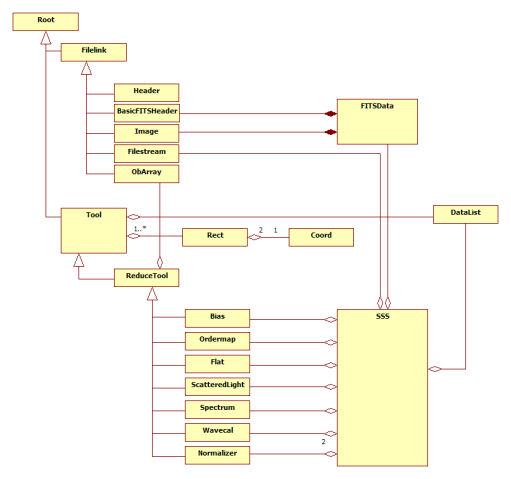The Solar-Stellar Spectrograph
[ Home | About | Tech Info & Data | Publications | References ] [ Site by Jeffrey Hall | Research funded by NSF ]
Reducing spectroscopic data with OIL
Almost all of the data reduction steps for the SSS project are carried out using the classes of OIL (Object IDL Library), which are documented in other articles in this section. The class documentation describes the methods and data members of each class, along with a general description of what it does. This article describes the library in general, and how to use it to reduce data.
Current code version

Code is not presently available for download.
Class hierarchy
The figure at right is a UML class diagram of the classes documented on this site. The principal class for reduction of SSS data is the SSS at lower right. It is a wrapper object that contains instances of the data (via the FITSData object) and the reducer objects that operate on the data. Anyone else wanting to use the OIL classes will have to write an analogous wrapper object (or just a procedure if desired) to reduce his or her data. The idea is to have the wrapper object initialize all the data members of the other classes to handle the specific data being reduced, and then call the classes' methods to operate on the data.
Assumptions about the data
The FITSData class assumes we are working with a BasicFITSHeader; i.e., a FITS frame with a single, 2880-byte header. This header stores the essential metadata (frame parameters, object ID, exposure date, time, and duration, and observer comments) in the standard FITS way.
The SSS class is obviously hard-wired to our particular data, resource files, and directory structure.
Key classes
Further articles in this section document the methods we use to reduce the data, concentrating primarily on how the seven reducer objects (derived from ReduceTool as shown in the figure at right) and the reduction methods of the SSS object work. In principle, those are the only classes you need to worry about in actually reducing data; the rest of the classes should be robust from one data format to another.
Continue to a description of a few initial data handling steps that precede reduction.

[Back to contents]
[ Back to my home page | Email me: jch [at] lowell [dot] edu ]
The SSS is publicly funded. Unless explicitly noted otherwise, everything on this site is in the public domain.
If you use or quote our results or images, we appreciate an acknowledgment.
This site is best viewed with Mozilla Firefox.